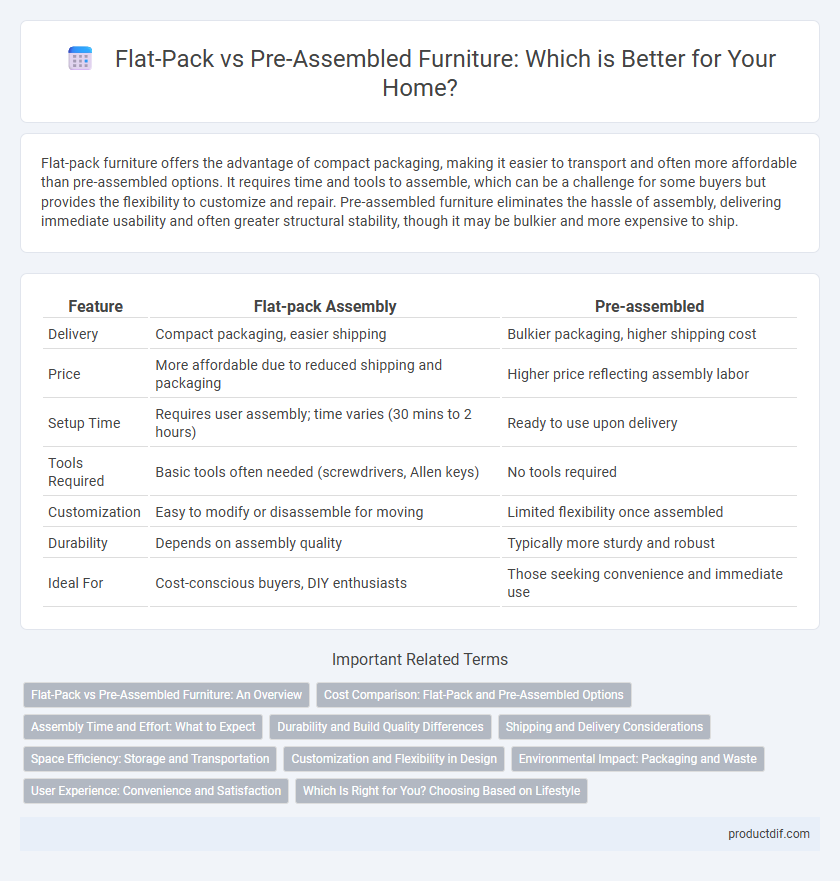Flat-pack furniture offers the advantage of compact packaging, making it easier to transport and often more affordable than pre-assembled options. It requires time and tools to assemble, which can be a challenge for some buyers but provides the flexibility to customize and repair. Pre-assembled furniture eliminates the hassle of assembly, delivering immediate usability and often greater structural stability, though it may be bulkier and more expensive to ship.
Table of Comparison
| Feature | Flat-pack Assembly | Pre-assembled |
|---|---|---|
| Delivery | Compact packaging, easier shipping | Bulkier packaging, higher shipping cost |
| Price | More affordable due to reduced shipping and packaging | Higher price reflecting assembly labor |
| Setup Time | Requires user assembly; time varies (30 mins to 2 hours) | Ready to use upon delivery |
| Tools Required | Basic tools often needed (screwdrivers, Allen keys) | No tools required |
| Customization | Easy to modify or disassemble for moving | Limited flexibility once assembled |
| Durability | Depends on assembly quality | Typically more sturdy and robust |
| Ideal For | Cost-conscious buyers, DIY enthusiasts | Those seeking convenience and immediate use |
Flat-Pack vs Pre-Assembled Furniture: An Overview
Flat-pack furniture offers cost-effectiveness and ease of transportation, making it a popular choice for budget-conscious consumers and small living spaces. Pre-assembled furniture provides immediate usability and often features higher craftsmanship and durability, appealing to those prioritizing convenience and long-term investment. Choosing between flat-pack and pre-assembled furniture depends on factors such as assembly skills, time availability, and space constraints.
Cost Comparison: Flat-Pack and Pre-Assembled Options
Flat-pack furniture typically costs less than pre-assembled pieces due to reduced manufacturing and shipping expenses, making it an economical choice for budget-conscious consumers. Pre-assembled furniture incurs higher costs because of increased labor and transportation fees associated with fully built items. Evaluating cost differences reveals that flat-pack options offer significant savings but require time and skill for assembly, while pre-assembled products provide convenience at a premium price.
Assembly Time and Effort: What to Expect
Flat-pack furniture requires significant assembly time and effort, often needing tools and detailed instructions, which can range from 30 minutes to several hours depending on complexity. Pre-assembled furniture eliminates this effort, arriving ready to use and saving valuable time, though it may involve higher shipping costs due to bulkier packaging. Understanding these differences helps consumers balance convenience against price and delivery considerations when choosing between flat-pack and pre-assembled options.
Durability and Build Quality Differences
Flat-pack furniture often features modular components designed for easy transport and assembly, but this can sometimes compromise durability due to weaker joints and thinner materials. Pre-assembled furniture typically undergoes factory quality control and uses robust construction methods, resulting in superior build quality and longer-lasting performance. Consumers seeking longevity and strength generally prefer pre-assembled options, while flat-pack units suit budget-conscious or space-limited needs.
Shipping and Delivery Considerations
Flat-pack furniture significantly reduces shipping costs due to its compact packaging, allowing more units per shipment and decreased freight expenses. Pre-assembled furniture, while convenient upon arrival, often incurs higher delivery fees and faces greater risk of damage during transit because of its bulkier size and weight. Efficient logistics and lower shipping costs make flat-pack assembly a popular choice for retailers and consumers prioritizing affordability and ease of delivery.
Space Efficiency: Storage and Transportation
Flat-pack furniture maximizes space efficiency by compactly nesting components, reducing storage volume and lowering transportation costs compared to pre-assembled pieces. Pre-assembled furniture demands more storage area and larger transport space due to its bulky, fixed structure, often leading to higher shipping and warehousing expenses. Optimizing logistics with flat-pack designs benefits retailers and consumers by facilitating easier handling and minimizing carbon footprint during distribution.
Customization and Flexibility in Design
Flat-pack assembly offers unmatched customization and flexibility in design, allowing users to modify components, choose finishes, and adapt furniture dimensions to fit specific spaces. Pre-assembled furniture often limits design options as it comes ready-built with fixed features, restricting personalization and room-specific adjustments. Consumers prioritizing tailored aesthetics and scalable configurations frequently prefer flat-pack solutions for their adaptability and creative control.
Environmental Impact: Packaging and Waste
Flat-pack furniture significantly reduces environmental impact by minimizing packaging materials, allowing more efficient shipping and less waste generation compared to pre-assembled pieces. The compact design of flat-pack items reduces carbon emissions during transportation due to increased shipping density. Pre-assembled furniture often involves bulkier packaging with higher material usage, contributing to greater landfill waste and environmental strain.
User Experience: Convenience and Satisfaction
Flat-pack assembly offers cost savings and customizable setup but can lead to frustration and time consumption for users lacking DIY skills. Pre-assembled furniture provides immediate usability and higher satisfaction through convenience, eliminating the need for tools or instructions. User preference often depends on balancing affordability with the desire for a hassle-free, ready-to-use product.
Which Is Right for You? Choosing Based on Lifestyle
Flat-pack furniture offers flexibility and cost savings, ideal for individuals with a keen DIY spirit and limited space, as it can be easily transported and assembled at home. Pre-assembled furniture suits those with busy lifestyles or limited time, providing immediate usability and often higher durability without the hassle of setup. Assess your daily routine, storage capacity, and comfort with assembly tasks to determine which option aligns best with your personal needs and convenience.
Flat-pack Assembly vs Pre-assembled Infographic

 productdif.com
productdif.com